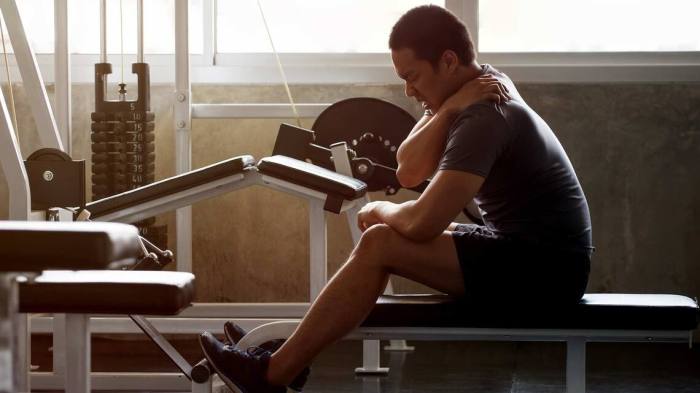What fitness injuries are among the easiest to avoid? This question sets the stage for this enthralling narrative, offering readers a glimpse into a story that is rich in detail and brimming with originality from the outset. Join us as we delve into the realm of avoidable fitness injuries, exploring the common pitfalls that can derail your fitness journey and uncovering the strategies to steer clear of them.
Fitness enthusiasts of all levels can benefit from this comprehensive guide, empowering themselves with the knowledge to prevent injuries and optimize their workouts. Whether you’re a seasoned athlete or just starting your fitness journey, this article will equip you with the tools and insights to stay injury-free and achieve your fitness goals.
Common Fitness Injuries that are Avoidable

Numerous fitness injuries are entirely avoidable, resulting from improper techniques, inadequate preparation, or excessive strain. Understanding these avoidable injuries and their causes empowers individuals to engage in fitness activities safely and effectively.
Identifying Risk Factors

Identifying risk factors that contribute to avoidable fitness injuries is crucial. These include poor form, inadequate warm-ups, and overtraining. Recognizing these factors allows individuals to modify their fitness routines and minimize the likelihood of injury.
Poor Form, What fitness injuries are among the easiest to avoid
Incorrect exercise form places undue stress on muscles, joints, and connective tissues, increasing the risk of strains, sprains, and other injuries. Maintaining proper form during exercises is paramount to prevent these avoidable injuries.
- Squats: Knees should not extend beyond toes, and back should remain straight.
- Deadlifts: Keep back straight, core engaged, and lift with legs.
- Push-ups: Body should form a straight line from head to heels, with elbows close to the body.
Inadequate Warm-ups
Neglecting warm-ups before exercise increases the risk of muscle strains and other injuries. Warm-ups prepare the body for physical activity by increasing blood flow, flexibility, and range of motion.
- Dynamic stretches: Lunges, arm circles, leg swings.
- Light cardio: Jogging, cycling, swimming.
Overtraining
Excessive training without adequate rest can lead to overtraining, increasing the risk of injuries. Rest and recovery are essential for muscle repair and tissue regeneration.
- Listen to your body: Rest when fatigued.
- Schedule rest days: Allow muscles to recover.
- Monitor training intensity: Gradually increase intensity to avoid overloading.
Importance of Proper Form
Maintaining proper form during exercises is crucial to prevent injuries. Incorrect form can lead to muscle imbalances, joint pain, and other health issues.
For example, improper squatting technique can strain the knees and lower back, while incorrect deadlifting form can injure the back. By adhering to proper form, individuals can effectively target muscle groups and minimize the risk of injuries.
Warm-up and Cool-down Procedures
Proper warm-ups and cool-downs are essential for injury prevention. Warm-ups prepare the body for physical activity, while cool-downs help reduce muscle soreness and stiffness.
Warm-up Procedures
- Dynamic stretches: Improve flexibility and range of motion.
- Light cardio: Increase blood flow and prepare cardiovascular system.
Cool-down Procedures
- Static stretches: Hold stretches for 10-15 seconds to improve flexibility.
- Light cardio: Gradually decrease heart rate and blood pressure.
Avoiding Overtraining
Overtraining occurs when the body is subjected to excessive physical activity without adequate rest. This can lead to injuries, burnout, and decreased performance.
To avoid overtraining, it is important to:
- Listen to your body: Rest when fatigued.
- Schedule rest days: Allow muscles to recover.
- Monitor training intensity: Gradually increase intensity to avoid overloading.
- Cross-train: Engage in different activities to prevent overuse of specific muscle groups.
Footwear and Equipment Selection

Choosing appropriate footwear and equipment is crucial for injury prevention. Supportive footwear can prevent foot and ankle injuries, while properly fitted equipment reduces the risk of strains and sprains.
- Footwear: Select shoes that provide adequate support, cushioning, and stability.
- Equipment: Choose equipment that is appropriate for your fitness level and goals.
Stretching and Flexibility
Regular stretching and flexibility exercises improve range of motion, reduce muscle soreness, and prevent injuries. Incorporating stretching into your fitness routine can significantly reduce the risk of muscle strains and other injuries.
Recommended stretching exercises include:
- Quadriceps stretch: Stand with feet hip-width apart, bend one knee, and grab your foot behind you.
- Hamstring stretch: Sit on the floor with legs extended, reach forward and touch your toes.
- Calf stretch: Stand facing a wall, step back with one leg, and lean into the wall until you feel a stretch in your calf.
Nutrition and Hydration: What Fitness Injuries Are Among The Easiest To Avoid
Proper nutrition and hydration are essential for injury prevention. A balanced diet provides the body with the nutrients it needs to repair and rebuild tissues, while adequate hydration prevents dehydration and muscle cramps.
Nutrient-rich foods include:
- Lean protein: Chicken, fish, beans.
- Fruits and vegetables: Provide antioxidants and vitamins.
- Whole grains: Rich in fiber and energy.
Injury Prevention Strategies

Implementing practical strategies can significantly reduce the risk of fitness injuries.
- Injury prevention programs: Designed to identify and address risk factors.
- Injury screening: Assesses individuals for potential injuries.
- Professional guidance: Consult with fitness professionals for personalized advice.
Helpful Answers
What are the most common avoidable fitness injuries?
Common avoidable fitness injuries include sprains, strains, overuse injuries, and muscle tears. These injuries often result from improper form, inadequate warm-ups, overtraining, or a combination of these factors.
How can I prevent fitness injuries?
To prevent fitness injuries, focus on maintaining proper form, warming up adequately before workouts, cooling down properly after workouts, avoiding overtraining, choosing appropriate footwear and equipment, stretching regularly, and ensuring optimal nutrition and hydration.
Why is proper form so important in preventing fitness injuries?
Proper form ensures that forces are distributed evenly throughout the body, reducing stress on specific joints and muscles. Incorrect form can lead to imbalances and excessive strain, increasing the risk of injuries.